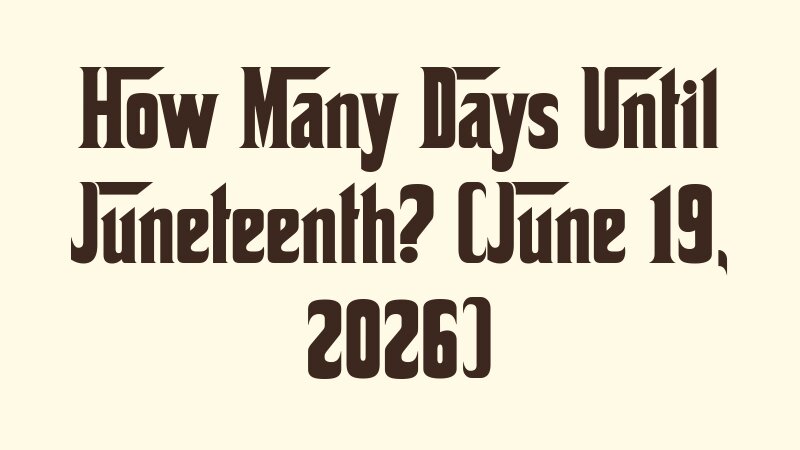Juneteenth Calendar (2026-2040)
| Year | Day | Date | Days Left |
|---|---|---|---|
| 2026 | Fri | June 19, 2026 | 206 days |
| 2027 | Sat | June 19, 2027 | 571 days |
| 2028 | Mon | June 19, 2028 | 937 days |
| 2029 | Tue | June 19, 2029 | 1302 days |
| 2030 | Wed | June 19, 2030 | 1667 days |
| 2031 | Thu | June 19, 2031 | 2032 days |
| 2032 | Sat | June 19, 2032 | 2398 days |
| 2033 | Sun | June 19, 2033 | 2763 days |
| 2034 | Mon | June 19, 2034 | 3128 days |
| 2035 | Tue | June 19, 2035 | 3493 days |
| 2036 | Thu | June 19, 2036 | 3859 days |
| 2037 | Fri | June 19, 2037 | 4224 days |
| 2038 | Sat | June 19, 2038 | 4589 days |
| 2039 | Sun | June 19, 2039 | 4954 days |
| 2040 | Tue | June 19, 2040 | 5320 days |
Juneteenth (short for “June Nineteenth”) marks the day—June 19, 1865—when the last enslaved people in the United States learned of their freedom in Galveston, Texas. You’ll often hear people call it Freedom Day or Emancipation Day. Today, communities celebrate with learning, reflection, food, music, and acts of service. This guide gives you the essentials, the history in plain language, and practical ways to join in—respectfully and meaningfully.
Key facts at a glance
- Date every year: June 19 (fixed, not a moving holiday).
- Core themes: freedom, reflection, remembrance, community, and progress.
- Common observances: educational talks, community gatherings, parades, concerts, and family cookouts.
Short history, in simple terms
Here’s the story in one breath: the Emancipation Proclamation took effect in 1863, but news and enforcement moved slower in some places. On June 19, 1865, Union troops arrived in Galveston and announced that enslaved people were free. That date became a symbol—a milestone to remember the end of slavery and to honor resilience and hope.
What Juneteenth feels like today
For many, Juneteenth is a day to learn, listen, and celebrate community. It’s joyful—think music, red-themed foods, and neighborhood gatherings—and it’s reflective, too. People honor the past, acknowledge ongoing challenges, and invest in a more inclusive future.
How to observe Juneteenth with care
- Learn something new: Read a book, watch a documentary, or attend a local talk. Share what you learn with friends and family.
- Support community events: Visit festivals, museum programs, or lectures that highlight history and culture.
- Give back: Volunteer or donate to organizations focused on education, opportunity, and community well-being.
- Celebrate through food and music: Host a respectful gathering, feature artists and authors, and uplift local vendors.
- Reflect: Take time for quiet remembrance and conversations that build understanding.
Respectful participation tips
Be curious, kind, and thoughtful. Ask questions, listen more than you speak, and center the day’s meaning. Avoid cultural appropriation and keep the focus on learning and community.
Frequently asked questions about Juneteenth
Is Juneteenth the same as the Emancipation Proclamation?
Not exactly. The Emancipation Proclamation (1863) declared freedom for enslaved people in Confederate states. Juneteenth (1865) marks when freedom was announced and enforced in Galveston, which turned the promise into lived reality for many who hadn’t yet heard—or seen—change.
Why “June 19” every year?
Because that’s the historic date of the Galveston announcement. So, unlike holidays that shift to Mondays, Juneteenth stays on June 19 annually.
What are traditional colors and foods?
Many use the color red to symbolize resilience and joy—think red drinks, strawberries, red velvet cake, and barbecue. Food traditions vary by region and family; follow local customs and celebrate respectfully.
How can families and schools take part?
Plan age-appropriate activities: read children’s books about freedom and fairness, create art projects, invite guest speakers, and highlight stories of perseverance and achievement.
Simple timeline you can remember
- 1863: Emancipation Proclamation takes effect.
- June 19, 1865: Freedom announced in Galveston, Texas—this becomes Juneteenth.
- Late 1800s–1900s: Communities across the U.S. observe and grow the tradition.
- Today: Juneteenth is widely celebrated with education, service, and community gatherings.
Ideas for community organizers
- Host a teach-in: Partner with libraries, museums, or local historians for short talks and Q&A.
- Plan inclusive festivities: Music, art, small business booths, and youth activities draw the whole neighborhood in.
- Create a resource hub: Share reading lists, local history sites, and year-round volunteer opportunities.
- Make it sustainable: Reusable water stations, recycling, and accessible spaces help everyone feel welcome.
Quick do’s and don’ts
- Do: Learn, listen, participate, and support local efforts.
- Do: Highlight voices from the community and uplift positive stories.
- Don’t: Commercialize or trivialize the holiday; keep the meaning at the center.
Short, shareable summary
Juneteenth honors freedom, resilience, and community. It’s a time to celebrate, reflect, and keep learning—together. Whether you’re attending a festival, cooking with family, or reading up on history, you’re part of a living tradition that turns remembrance into action.
Related terms you might see
- Emancipation Day: Another name used in some places for the same observance.
- Freedom Day: A popular nickname that captures the heart of the celebration.
- Jubliee / Jubilee Day: A historic term you may encounter in older sources.
Helpful next steps
- Find a local event: Check community calendars, museums, and libraries.
- Build a reading list: Pick a few books or articles and discuss them with friends or family.
- Give back: Choose a community organization and support it year-round.
However you take part, keep the message at heart: learn from the past, celebrate progress, and invest in one another.
